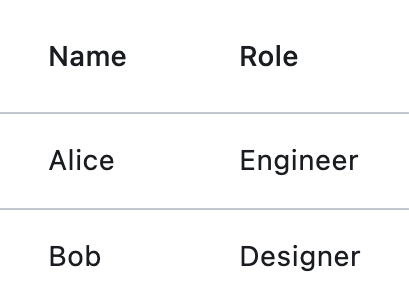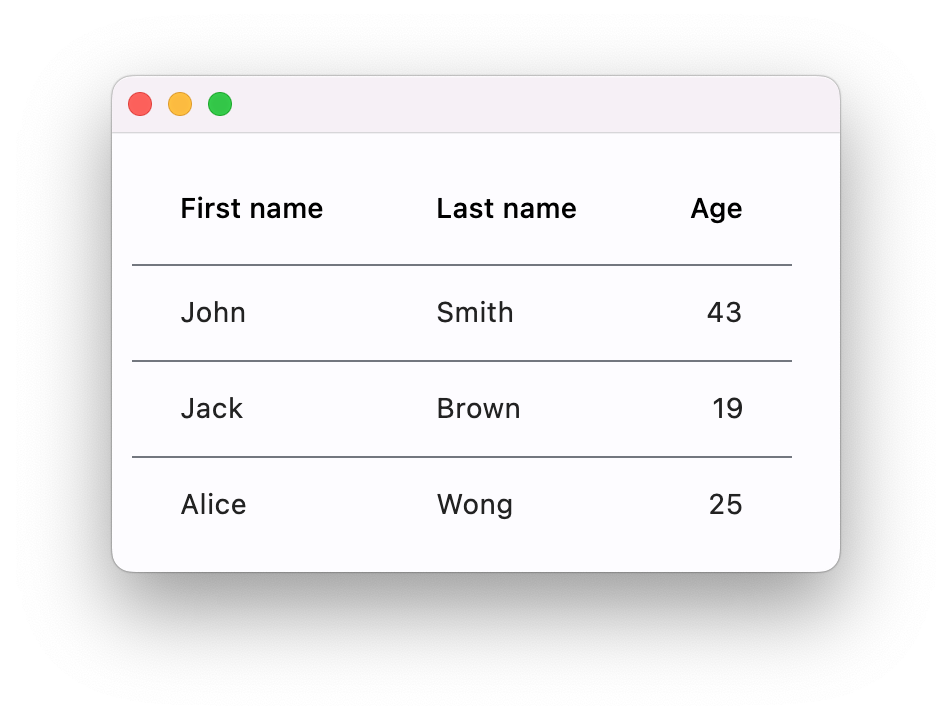DataTable#
Basic DataTable
Inherits: LayoutControl
Properties
-
bgcolor(ColorValue | None) –The background color for this table.
-
border(Border | None) –The border around the table.
-
border_radius(BorderRadiusValue | None) –Border corners.
-
checkbox_horizontal_margin(Number | None) –Horizontal margin around the checkbox, if it is displayed.
-
clip_behavior(ClipBehavior) –Defines how the contents of this table are clipped.
-
column_spacing(Number | None) –The horizontal margin between the contents of each data column.
-
columns(list[DataColumn]) –A list of
DataColumncontrols describing table columns. -
data_row_color(ControlStateValue[ColorValue] | None) –The background color for the data rows.
-
data_row_max_height(Number | None) –The maximum height of each row (excluding the row that contains column headings).
-
data_row_min_height(Number | None) –The minimum height of each row (excluding the row that contains column headings).
-
data_text_style(TextStyle | None) –The text style of the data
rows. -
divider_thickness(Number) –The width of the divider that appears between
rows. -
gradient(Gradient | None) –The background gradient of this table.
-
heading_row_color(ControlStateValue[ColorValue] | None) –The background color for the heading row.
-
heading_row_height(Number | None) –The height of the heading row.
-
heading_text_style(TextStyle | None) –The text style for the heading row.
-
horizontal_lines(BorderSide | None) –Set the color and width of horizontal
-
horizontal_margin(Number | None) –The horizontal margin between the edges of this table and the content in the first
-
rows(list[DataRow]) –A list of
DataRowcontrols defining table rows. -
show_bottom_border(bool) –Whether a border at the bottom of the table is displayed.
-
show_checkbox_column(bool) –Whether the control should display checkboxes for selectable rows.
-
sort_ascending(bool) –Whether the column mentioned in
sort_column_index, -
sort_column_index(int | None) –The current primary sort key's column.
-
vertical_lines(BorderSide | None) –Set the color and width of vertical lines
Events
-
on_select_all(ControlEventHandler[DataTable] | None) –Invoked when the user selects or unselects every row, using the checkbox in the
Examples#
Basic Example#
import flet as ft
def main(page: ft.Page):
page.add(
ft.DataTable(
columns=[
ft.DataColumn(label=ft.Text("First name")),
ft.DataColumn(label=ft.Text("Last name")),
ft.DataColumn(label=ft.Text("Age"), numeric=True),
],
rows=[
ft.DataRow(
cells=[
ft.DataCell(ft.Text("John")),
ft.DataCell(ft.Text("Smith")),
ft.DataCell(ft.Text("43")),
],
),
ft.DataRow(
cells=[
ft.DataCell(ft.Text("Jack")),
ft.DataCell(ft.Text("Brown")),
ft.DataCell(ft.Text("19")),
],
),
ft.DataRow(
cells=[
ft.DataCell(ft.Text("Alice")),
ft.DataCell(ft.Text("Wong")),
ft.DataCell(ft.Text("25")),
],
),
],
),
)
ft.run(main)
Sortable columns and selectable rows#
import flet as ft
def main(page: ft.Page):
page.add(
ft.DataTable(
width=700,
bgcolor=ft.Colors.YELLOW,
border=ft.border.all(2, ft.Colors.RED),
border_radius=10,
vertical_lines=ft.border.BorderSide(3, ft.Colors.BLUE),
horizontal_lines=ft.border.BorderSide(1, ft.Colors.GREEN),
sort_column_index=0,
sort_ascending=True,
heading_row_color=ft.Colors.BLACK12,
heading_row_height=100,
data_row_color={ft.ControlState.HOVERED: "0x30FF0000"},
show_checkbox_column=True,
divider_thickness=0,
column_spacing=200,
columns=[
ft.DataColumn(
label=ft.Text("Column 1"),
on_sort=lambda e: print(f"{e.column_index}, {e.ascending}"),
),
ft.DataColumn(
label=ft.Text("Column 2"),
tooltip="This is a second column",
numeric=True,
on_sort=lambda e: print(f"{e.column_index}, {e.ascending}"),
),
],
rows=[
ft.DataRow(
cells=[ft.DataCell(ft.Text("A")), ft.DataCell(ft.Text("1"))],
selected=True,
on_select_change=lambda e: print(f"row select changed: {e.data}"),
),
ft.DataRow([ft.DataCell(ft.Text("B")), ft.DataCell(ft.Text("2"))]),
],
),
)
ft.run(main)
Handling events#
import flet as ft
def main(page: ft.Page):
def handle_row_selection_change(e: ft.Event[ft.DataRow]):
match e.control.data:
case 1:
row1.selected = not row1.selected
case 2:
row2.selected = not row2.selected
case 3:
row3.selected = not row3.selected
page.update()
def handle_column_sort(e: ft.DataColumnSortEvent):
match e.control.data:
case 1:
print(f"{e.column_index}, {e.ascending}")
# table.sort_column_index = 1
table.sort_ascending = e.ascending
case 2:
print(f"{e.column_index}, {e.ascending}")
# table.sort_column_index = 2
table.sort_ascending = e.ascending
page.update()
page.add(
table := ft.DataTable(
width=700,
bgcolor=ft.Colors.TEAL_ACCENT_200,
border=ft.Border.all(2, ft.Colors.RED_ACCENT_200),
border_radius=10,
vertical_lines=ft.border.BorderSide(3, ft.Colors.BLUE_600),
horizontal_lines=ft.border.BorderSide(1, ft.Colors.GREEN_600),
sort_column_index=0,
sort_ascending=True,
heading_row_color=ft.Colors.BLACK12,
heading_row_height=100,
data_row_color={ft.ControlState.HOVERED: "0x30FF0000"},
show_checkbox_column=True,
divider_thickness=0,
column_spacing=200,
columns=[
ft.DataColumn(
label=ft.Text("Column 1"),
tooltip="This is the first column",
data=1,
on_sort=handle_column_sort,
),
ft.DataColumn(
label=ft.Text("Column 2"),
tooltip="This is a second column",
numeric=True,
data=2,
on_sort=handle_column_sort,
),
],
rows=[
row1 := ft.DataRow(
cells=[ft.DataCell(ft.Text("A")), ft.DataCell(ft.Text("1"))],
selected=True,
on_select_change=handle_row_selection_change,
data=1,
),
row2 := ft.DataRow(
cells=[ft.DataCell(ft.Text("B")), ft.DataCell(ft.Text("2"))],
selected=False,
on_select_change=handle_row_selection_change,
data=2,
),
row3 := ft.DataRow(
cells=[ft.DataCell(ft.Text("C")), ft.DataCell(ft.Text("3"))],
selected=False,
on_select_change=handle_row_selection_change,
data=3,
),
],
)
)
ft.run(main)
Properties#
class-attribute
instance-attribute
#
bgcolor: ColorValue | None = None
The background color for this table.
class-attribute
instance-attribute
#
border: Border | None = None
The border around the table.
class-attribute
instance-attribute
#
border_radius: BorderRadiusValue | None = None
Border corners.
class-attribute
instance-attribute
#
checkbox_horizontal_margin: Number | None = None
Horizontal margin around the checkbox, if it is displayed.
class-attribute
instance-attribute
#
clip_behavior: ClipBehavior = NONE
Defines how the contents of this table are clipped.
class-attribute
instance-attribute
#
column_spacing: Number | None = None
The horizontal margin between the contents of each data column.
instance-attribute
#
columns: list[DataColumn]
A list of DataColumn controls describing table columns.
Raises:
-
ValueError–If there are no visible
columns.
class-attribute
instance-attribute
#
data_row_color: ControlStateValue[ColorValue] | None = None
The background color for the data rows.
The effective background color can be made to depend on the
ControlState state, i.e. if the row is selected, pressed, hovered,
focused, disabled or enabled. The color is painted as an overlay to the row.
To make sure that the row's InkWell is visible (when pressed, hovered and focused),
it is recommended to use a translucent background color.
class-attribute
instance-attribute
#
data_row_max_height: Number | None = None
The maximum height of each row (excluding the row that contains column headings).
Set to float("inf") for the height of each row to adjust automatically with its
content.
Defaults to 48.0.
Note
Must be greater than or equal to data_row_min_height.
Raises:
-
ValueError–If
data_row_max_heightis less thandata_row_min_height.
class-attribute
instance-attribute
#
data_row_min_height: Number | None = None
The minimum height of each row (excluding the row that contains column headings).
Defaults to 48.0.
Note
Must be less than or equal to data_row_max_height.
Raises:
-
ValueError–If
data_row_min_heightis greater thandata_row_max_height.
class-attribute
instance-attribute
#
data_text_style: TextStyle | None = None
The text style of the data rows.
class-attribute
instance-attribute
#
divider_thickness: Number = 1.0
The width of the divider that appears between rows.
Note
Must be greater than or equal to zero.
Raises:
-
ValueError–If
divider_thicknessis negative.
class-attribute
instance-attribute
#
gradient: Gradient | None = None
The background gradient of this table.
class-attribute
instance-attribute
#
heading_row_color: ControlStateValue[ColorValue] | None = (
None
)
The background color for the heading row.
The effective background color can be made to depend on the
ControlState state, i.e. if the row is pressed, hovered,
focused when sorted. The color is painted as an overlay to the row. To make sure
that the row's InkWell is visible (when pressed, hovered and focused), it is
recommended to use a translucent color.
class-attribute
instance-attribute
#
heading_row_height: Number | None = None
The height of the heading row.
class-attribute
instance-attribute
#
heading_text_style: TextStyle | None = None
The text style for the heading row.
class-attribute
instance-attribute
#
horizontal_lines: BorderSide | None = None
Set the color and width of horizontal lines between rows.
class-attribute
instance-attribute
#
horizontal_margin: Number | None = None
The horizontal margin between the edges of this table and the content in the first and last cells of each row.
When a checkbox is displayed, it is also the margin between the checkbox the content in the first data column.
class-attribute
instance-attribute
#
show_bottom_border: bool = False
Whether a border at the bottom of the table is displayed.
By default, a border is not shown at the bottom to allow for a border around the table defined by decoration.
class-attribute
instance-attribute
#
show_checkbox_column: bool = False
Whether the control should display checkboxes for selectable rows.
If True, a checkbox will be placed at the beginning of each row that is
selectable. However, if DataRow.on_select_change
is not set for any row, checkboxes will not be placed, even if this value is True.
If False, all rows will not display a checkbox.
class-attribute
instance-attribute
#
sort_ascending: bool = False
Whether the column mentioned in sort_column_index,
if any, is sorted in ascending order.
If True, the order is ascending (meaning the rows with the smallest values for
the current sort column are first in the table).
If False, the order is descending (meaning the rows with the smallest values for
the current sort column are last in the table).
class-attribute
instance-attribute
#
sort_column_index: int | None = None
The current primary sort key's column.
If specified, indicates that the indicated column is the column by which the data
is sorted. The number must correspond to the index of the relevant column in
columns.
Setting this will cause the relevant column to have a sort indicator displayed.
When this is None, it implies that the table's sort order does not correspond to
any of the columns.
Raises:
-
ValueError–If
sort_column_indexis out of range relative to the visiblecolumns.
class-attribute
instance-attribute
#
vertical_lines: BorderSide | None = None
Set the color and width of vertical lines between columns.
Events#
class-attribute
instance-attribute
#
on_select_all: ControlEventHandler[DataTable] | None = None
Invoked when the user selects or unselects every row, using the checkbox in the heading row.
If this is None, then the DataRow.on_select_change
callback of every row of this table is invoked appropriately instead.
Tip
To control whether a particular row is selectable or not, see
DataRow.on_select_change. This callback is only relevant if
any row is selectable.


